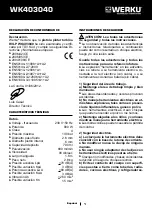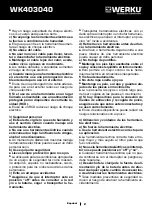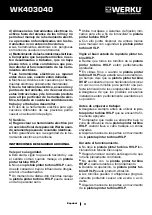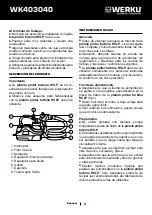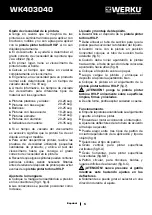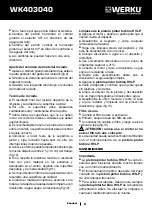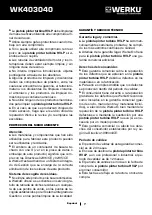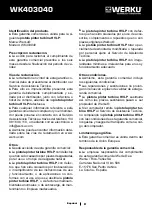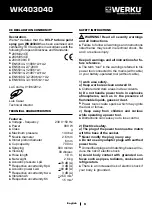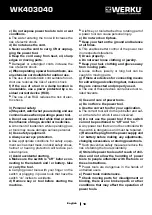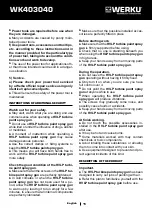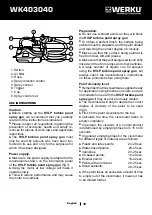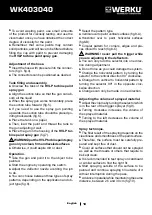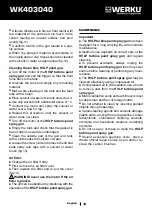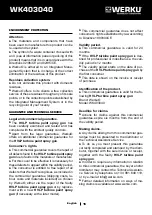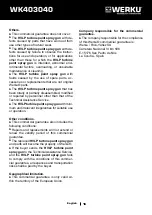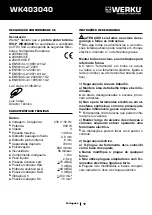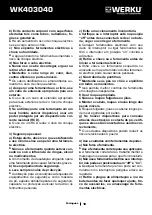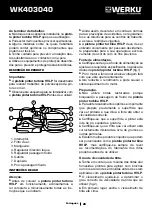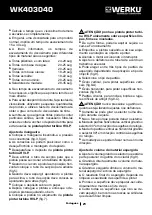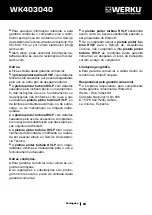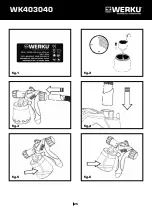
10
English
WK403040
c) Do not expose power tools to rain or wet
conditions.
►
The water entering the tool will increase the
risk of electric shock.
d) Do not abuse the cord.
►
Never use the cord to carry, lift or unplug-
ging the power tool.
►
Keep the cord away from heat, oil, sharp
edges or moving parts.
►
Damaged or entangled cords increase the
risk of electric shock.
e) When operating a power tool outdoors, use
an extension cord suitable for outdoor use.
►
The use of an extension cord suitable for out-
door use reduces the risk of electric shock.
f) If the use of a tool in a damp location is
unavailable, use a power protected by a re-
sidual current device (RCD).
►
The use of an RCD reduces the risk of elec-
tric shock.
3) Personal safety.
a) Stay alert, watch what you are doing and use
common sense when operating a power tool.
►
Do not use a power tool while tired or under
the influence of drugs, alcohol or medicines.
►
A moment of inattention while operating pow-
er tools may cause damage serious personal.
b) Use safety equipment.
►
Always wear eye protection.
►
Use appropriate conditions for safety equip-
ment such as dust mask, nonskid safety shoes,
helmet or hearing protection will reduce per-
sonal injuries.
c) Avoid accidental starting.
►
Make sure the switch is “off” before con
-
necting to the network and / or battery, take
or carry the tool.
►
Carrying power tools with your finger on the
switch or plugging in power tools that have the
switch “on” invites to accidents.
d) Remove key or tool before starting the
machine.
►
A left key or tool attached to a rotating part of
a power tool can cause personal injury.
e) Do not work on tiptoes.
►
Keep your feet on the ground and balance
at all times.
►
This enables better control of the power tool
in unexpected situations.
f) Dress properly.
►
Do not wear loose clothing or jewelry.
►
Keep your hair, clothing and gloves away
from moving parts.
►
Loose clothes, jewelry or long hair can be
caught in moving parts.
g) If there are devices for connecting means
for extracting and collecting dust, make sure
they are connected and properly used.
►
The use of these devices can reduce dust re-
lated hazards.
4) Use and care of power tools.
a) Do not force the power tool.
►
Use the correct tool for your application.
►
The correct tool will do the job better and saf-
er at the rate for which it was conceived.
b) Do not use the power tool if the switch
can not be positioned to “off” and “on.”
►
Any power tool that can not be controlled with
the switch is dangerous and must be repaired.
c) Remove the plug from the power supply and
/ or battery before making any adjustments,
changing accessories, or storing power tools.
►
Such preventive safety measures reduce the
risk of starting the tool accidentally.
d) Store idle power tools out of reach of chil-
dren and not allow the handling of power
tools to people unfamiliar with the tools or
these instructions.
►
Power tools are dangerous in the hands of
untrained users.
e) Power tools maintenance.
►
Check moving parts for misalignment or
binding, there are no broken parts or other
conditions that may affect the operation of
power tools.
Summary of Contents for WK403040
Page 26: ...25 WK403040 fig 1 fig 2 fig 3 fig 4 fig 5 fig 6...
Page 27: ...26 WK403040 fig 7 fig 8 fig 9 fig 10 fig 11 fig 12...
Page 28: ...27 WK403040 fig 13 fig 14...
Page 29: ...28 WK403040...
Page 30: ...29 WK403040...
Page 31: ...30 WK403040...


